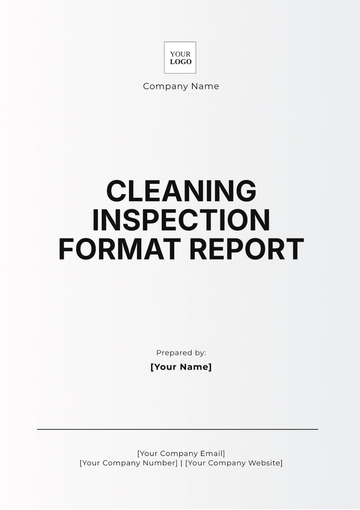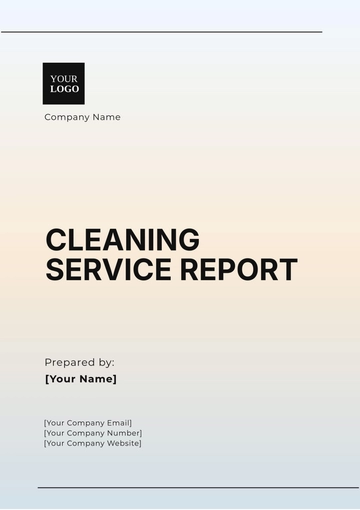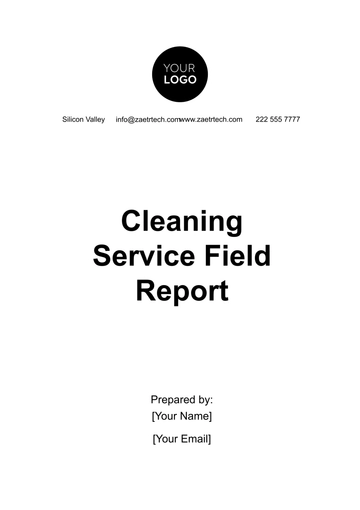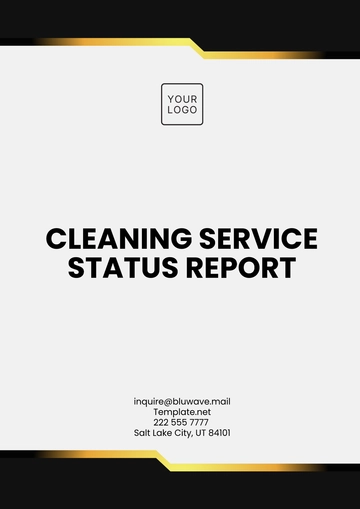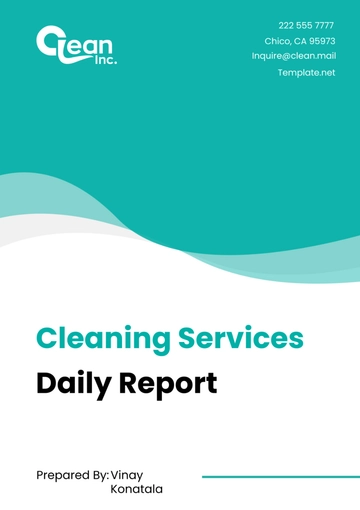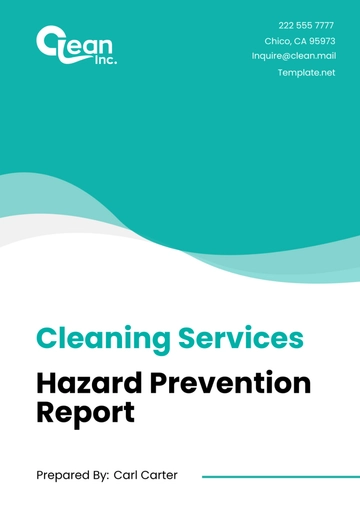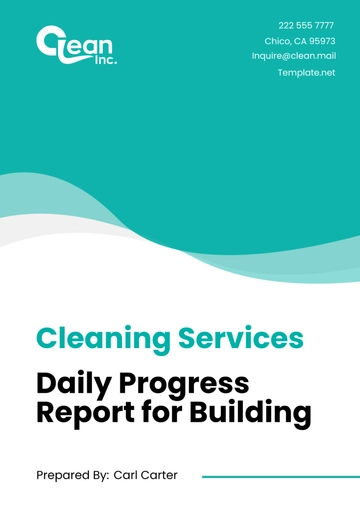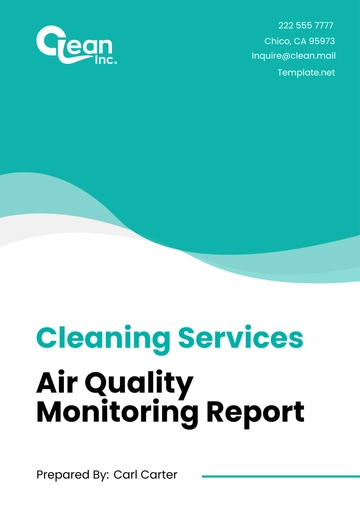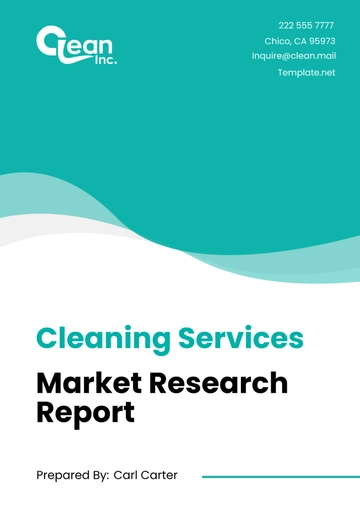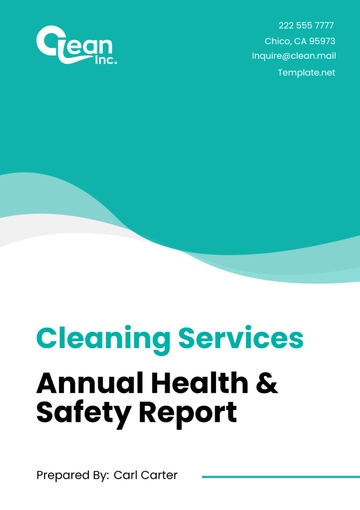Free Cleaning Services Hazard Prevention Report
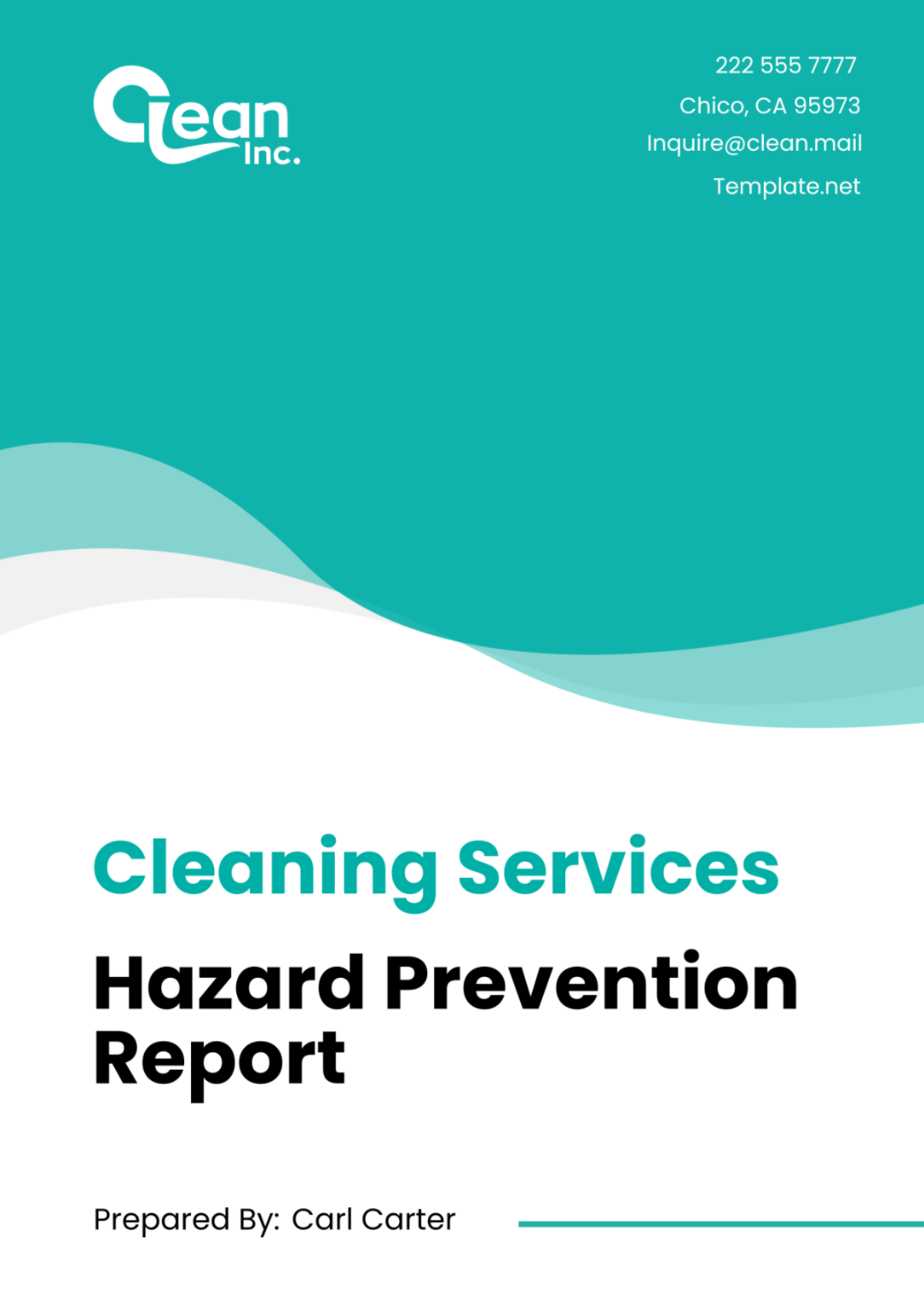
At [YOUR COMPANY NAME], ensuring the well-being and safety of our employees and clients is not just a policy; it's a commitment. The nature of cleaning services inherently involves various risks, from the handling of chemicals to the potential for slips and falls. Recognizing these risks, our aim is to not only identify and evaluate potential hazards but also to implement robust prevention strategies that safeguard against these risks. This report is a testament to our dedication to creating a safer working environment and demonstrates our proactive approach to hazard management.
1. Overview
In the highly competitive cleaning industry, the safety of our workers and clients stands as our highest priority. It's a well-known fact that a safer workplace not only contributes to the well-being of employees but also enhances productivity and client satisfaction. Therefore, this report has been meticulously prepared to focus on the dual objectives of identifying potential risks associated with cleaning operations and implementing effective hazard prevention strategies. By doing so, [YOUR COMPANY NAME] aims to set a benchmark for safety standards within the cleaning industry.
2. Hazard Identification and Evaluation
The cleaning industry encompasses a variety of tasks, each carrying its own set of potential risks. From the use of chemicals to physical exertion, it is imperative to understand these risks thoroughly. This section aims to not only identify these potential hazards but also to evaluate their impact and propose initial interventions. The goal is to mitigate these risks proactively, ensuring the safety and health of all involved.
Hazard Identification Table
Hazard | Potential Adverse Effects | Interventions |
|---|---|---|
Slip hazards | Sprains, fractures, and other serious injuries | Implementing a regular floor drying schedule to ensure surfaces are kept dry and non-slippery. Additionally, placing warning signs around wet areas can alert individuals to potential slip risks. |
Chemical hazards | Burns, allergic reactions, and respiratory issues | Conducting safe chemical handling training for all staff. This includes the proper storage, use, and disposal of chemicals, along with the use of appropriate PPE to protect against chemical exposure. |
Physical hazards | Falls from heights, strains from lifting, and equipment-related injuries | Providing comprehensive equipment handling training, which covers the safe use of cleaning machinery and tools, as well as techniques for safe lifting and moving of heavy objects to prevent strains and injuries. |
Biological hazards | Infections, diseases from contact with contaminated surfaces or waste | Enforcing the use of personal protective equipment, such as gloves and masks, especially in areas with a high risk of biological contamination. Regular training on hygiene practices is also vital to minimize the risk of disease transmission. |
PPE-related hazards | Skin irritation, heat stress from prolonged use of protective gear | Developing and adapting a proper PPE usage protocol that includes selecting the right PPE for the job, ensuring a proper fit for the wearer, and providing training on how to wear, adjust, and when to replace the PPE to prevent discomfort and health issues. |
Each of these hazards has been carefully considered for its frequency of occurrence and the seriousness of potential adverse effects. By implementing the suggested interventions, [YOUR COMPANY NAME] aims to significantly reduce the likelihood of these hazards materializing and to mitigate their impact should they occur. These interventions are designed not only as immediate measures but also as part of an ongoing process of safety review and improvement.
The successful identification and evaluation of hazards in cleaning services are crucial first steps towards establishing a safer working environment. However, it is the continuous commitment to implementing and updating hazard prevention strategies that truly defines a safety-first culture. At [YOUR COMPANY NAME], we believe in not only adhering to current safety standards but also in leading by example, pushing the boundaries of what is possible in workplace safety within the cleaning industry. This report underscores our dedication to this cause, laying the groundwork for a comprehensive safety program that will continue to evolve in response to new challenges and advancements in safety practices.
3. Risk Evaluation
In the process of maintaining a safe working environment, the evaluation of risks associated with cleaning services is a critical step. This evaluation not only identifies the potential hazards but also assesses them based on their frequency and severity, allowing [YOUR COMPANY NAME] to prioritize interventions effectively. High-severity and high-frequency hazards are given precedence in the implementation of preventive measures due to their potential impact on the health and safety of employees and clients. Here's a closer examination of the risks identified:
Persistent Exposure to Cleaning Chemicals: Regular interaction with cleaning chemicals is an inherent part of the job. However, this exposure carries a significant risk of causing respiratory and skin diseases. The severity of these conditions can range from mild irritations to severe, long-term health issues, emphasizing the need for stringent control measures.
Ergonomic Injuries: The repetitive nature of manual cleaning practices makes ergonomic injuries a common workplace hazard. These injuries can result from improper lifting techniques, prolonged standing, or repetitive motion, leading to conditions such as musculoskeletal disorders which significantly impact the well-being of employees.
Slip and Fall Accidents: Though of moderate frequency, the consequences of slip and fall accidents can be severe, resulting in sprains, fractures, or more serious injuries. These accidents underscore the importance of maintaining clean, dry, and obstruction-free floors in all areas.
Biological Hazards: The risk of infections or diseases from biological contaminants is high, though these hazards are less frequent. Employees working in environments where they are exposed to biological waste or contaminated surfaces are at a higher risk, necessitating protective measures.
Electrical Hazards: Electrical hazards, including shocks and burns, pose a significant risk in environments where electrical equipment is used or where there is potential exposure to water. Although less common, the potential severity of these incidents requires that they are addressed with appropriate safety protocols.
4. Prevention and Control Measures
To mitigate the identified risks, [YOUR COMPANY NAME] is committed to implementing a comprehensive set of prevention and control measures. These measures are designed to not only protect employees and clients but also to promote a culture of safety within the workplace. The following strategies have been developed:
Regular Training Programs: A cornerstone of our hazard prevention strategy is the regular training of staff. These programs are aimed at educating employees on the recognition, reporting, and mitigation of hazards. Training covers a wide range of topics, from safe chemical handling and ergonomics to emergency response protocols, ensuring that all employees are well-equipped to work safely.
Provision and Strict Enforcement of Proper Personal Protective Equipment (PPE): To protect against chemical, biological, and physical hazards, the provision of appropriate PPE is essential. Strict enforcement ensures that all employees use PPE correctly and consistently, significantly reducing the risk of exposure to hazardous materials.
Continual Improvement of Work Protocols and Procedures: [YOUR COMPANY NAME] is committed to the continuous review and improvement of work protocols and procedures. By staying abreast of industry best practices and technological advancements, the company ensures that its safety protocols are effective and efficient.
Instituting Regular Health Checks and Vaccinations: For employees exposed to biological hazards, regular health checks and vaccinations are vital preventive measures. These health initiatives help to identify any adverse effects early and provide protection against specific biological threats.
Developing an Emergency Response and Proper Handling of Hazardous Materials: Comprehensive emergency response plans and proper hazardous material handling protocols are critical. These plans ensure that employees are prepared to respond effectively in the event of an incident, minimizing the impact and preventing further harm.
By implementing these prevention and control measures, [YOUR COMPANY NAME] demonstrates its unwavering commitment to the safety and well-being of its employees and clients. Through continuous evaluation, training, and improvement, the company sets a high standard for safety within the cleaning industry, ensuring that it remains a leader in creating a safe and healthy work environment.
5. Recommendations
In striving towards a safer workplace, [YOUR COMPANY NAME] acknowledges that the foundation of a robust safety program lies not only in the implementation of protocols but also in cultivating a proactive safety culture. This culture is built upon the principles of rigorous reporting, employee participation, transparency, investment in safety equipment, and continual review of safety protocols. Here’s an elaboration on these pivotal recommendations:
Develop a Culture of Rigorous Reporting of Hazards Including "Near-Miss" Incidents
A critical step towards mitigating hazards is the establishment of a rigorous reporting system that captures all incidents, including near misses. Near misses, often overlooked, are valuable learning opportunities that provide insights into potential hazards before they result in injury. Encouraging the reporting of these incidents helps in identifying and rectifying potential safety issues early on. Implementing a non-punitive reporting system will reassure employees that their safety is of paramount importance and that reporting is an integral part of their responsibility towards maintaining a safe work environment.
Encourage Employees to Participate Actively in Safety Measures and the Development of Work Protocols
Active employee participation is key to the success of any safety program. Employees who are directly involved in the cleaning operations have firsthand experience and can offer valuable insights into potential hazards and effective preventive measures. Facilitating their involvement in the development and refinement of work protocols not only enhances the effectiveness of these measures but also fosters a sense of ownership and commitment towards workplace safety. Regular safety meetings, suggestion boxes, and safety committees are excellent avenues for encouraging employee participation.
Promote Transparency and Open Communication Where Hazard Concerns Are Raised
Transparency and open communication form the cornerstone of trust within the workplace. Creating an environment where employees feel comfortable raising concerns about potential hazards without fear of reprisal is crucial. Management should actively encourage this dialogue by being approachable and responsive to concerns raised. Regular updates on the steps taken to address reported hazards can further reinforce trust and encourage continuous feedback, creating a cycle of improvement.
Invest in Necessary Safety Equipment and Ensure They Are Always in Good Working Condition
The right tools and equipment are fundamental to safety in cleaning operations. Investing in high-quality personal protective equipment (PPE), safe cleaning products, and well-designed tools not only demonstrates a commitment to employee well-being but also significantly reduces the risk of accidents and injuries. Equally important is the maintenance of this equipment to ensure it remains in good working condition. Regular inspections, maintenance schedules, and easy access to replacement or repair services are essential practices that support this investment.
Review Safety Protocols Annually or Whenever a Significant Change Occurs in Cleaning Procedures or Products
The dynamic nature of the cleaning industry, with its evolving techniques, products, and regulations, necessitates the regular review of safety protocols. An annual review, at a minimum, ensures that these protocols remain relevant and effective in addressing current hazards. Additionally, any significant change in cleaning procedures, products, or equipment should trigger a safety review to assess and mitigate any new risks that may arise. This adaptive approach ensures that the safety program remains proactive rather than reactive, keeping pace with industry developments and maintaining a high standard of safety.
By adopting these recommendations, [YOUR COMPANY NAME] can further strengthen its safety program, building a resilient and proactive culture that prioritizes the health and safety of its employees and clients. This culture, characterized by vigilance, participation, and continuous improvement, not only mitigates risks but also contributes to the overall success and reputation of the company as a leader in workplace safety within the cleaning industry.
6. Conclusion
At [YOUR COMPANY NAME], the well-being and safety of our employees and clients are at the forefront of our mission. Through the diligent identification and strategic mitigation of potential hazards detailed in this report, we have laid the groundwork for a safer work environment. This commitment to continuous improvement and review of our safety measures will enable us to maintain a leading position in safety standards. By prioritizing safety, we not only protect our team and clients but also enhance productivity and strengthen our brand image, reinforcing [YOUR COMPANY NAME]'s reputation as a conscientious and reliable provider in the cleaning industry.
- 100% Customizable, free editor
- Access 1 Million+ Templates, photo’s & graphics
- Download or share as a template
- Click and replace photos, graphics, text, backgrounds
- Resize, crop, AI write & more
- Access advanced editor
Safeguard your cleaning services operations with our Hazard Prevention Report Template. This indispensable tool from Template.net empowers you to proactively identify and address potential hazards. Customize the report effortlessly using our AI editor tool to suit your specific requirements. Conduct comprehensive assessments to mitigate risks effectively. Elevate your hazard prevention measures and ensure a safe working environment for your team and clients.
You may also like
- Sales Report
- Daily Report
- Project Report
- Business Report
- Weekly Report
- Incident Report
- Annual Report
- Report Layout
- Report Design
- Progress Report
- Marketing Report
- Company Report
- Monthly Report
- Audit Report
- Status Report
- School Report
- Reports Hr
- Management Report
- Project Status Report
- Handover Report
- Health And Safety Report
- Restaurant Report
- Construction Report
- Research Report
- Evaluation Report
- Investigation Report
- Employee Report
- Advertising Report
- Weekly Status Report
- Project Management Report
- Finance Report
- Service Report
- Technical Report
- Meeting Report
- Quarterly Report
- Inspection Report
- Medical Report
- Test Report
- Summary Report
- Inventory Report
- Valuation Report
- Operations Report
- Payroll Report
- Training Report
- Job Report
- Case Report
- Performance Report
- Board Report
- Internal Audit Report
- Student Report
- Monthly Management Report
- Small Business Report
- Accident Report
- Call Center Report
- Activity Report
- IT and Software Report
- Internship Report
- Visit Report
- Product Report
- Book Report
- Property Report
- Recruitment Report
- University Report
- Event Report
- SEO Report
- Conference Report
- Narrative Report
- Nursing Home Report
- Preschool Report
- Call Report
- Customer Report
- Employee Incident Report
- Accomplishment Report
- Social Media Report
- Work From Home Report
- Security Report
- Damage Report
- Quality Report
- Internal Report
- Nurse Report
- Real Estate Report
- Hotel Report
- Equipment Report
- Credit Report
- Field Report
- Non Profit Report
- Maintenance Report
- News Report
- Survey Report
- Executive Report
- Law Firm Report
- Advertising Agency Report
- Interior Design Report
- Travel Agency Report
- Stock Report
- Salon Report
- Bug Report
- Workplace Report
- Action Report
- Investor Report
- Cleaning Services Report
- Consulting Report
- Freelancer Report
- Site Visit Report
- Trip Report
- Classroom Observation Report
- Vehicle Report
- Final Report
- Software Report
